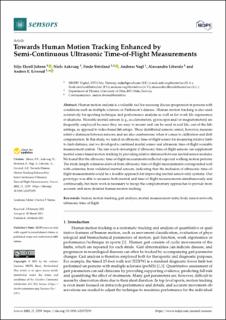| dc.description.abstract | Human motion analysis is a valuable tool for assessing disease progression in persons with conditions such as multiple sclerosis or Parkinson’s disease. Human motion tracking is also used extensively for sporting technique and performance analysis as well as for work life ergonomics evaluations. Wearable inertial sensors (e.g., accelerometers, gyroscopes and/or magnetometers) are frequently employed because they are easy to mount and can be used in real life, out-of-the-lab settings, as opposed to video-based lab setups. These distributed sensors cannot, however, measure relative distances between sensors, and are also cumbersome when it comes to calibration and drift compensation. In this study, we tested an ultrasonic time-of-flight sensor for measuring relative limb-to-limb distance, and we developed a combined inertial sensor and ultrasonic time-of-flight wearable measurement system. The aim was to investigate if ultrasonic time-of-flight sensors can supplement inertial sensor-based motion tracking by providing relative distances between inertial sensor modules. We found that the ultrasonic time-of-flight measurements reflected expected walking motion patterns. The stride length estimates derived from ultrasonic time-of-flight measurements corresponded well with estimates from validated inertial sensors, indicating that the inclusion of ultrasonic time-of flight measurements could be a feasible approach for improving inertial sensor-only systems. Our prototype was able to measure both inertial and time-of-flight measurements simultaneously and continuously, but more work is necessary to merge the complementary approaches to provide more accurate and more detailed human motion tracking. | en_US |

